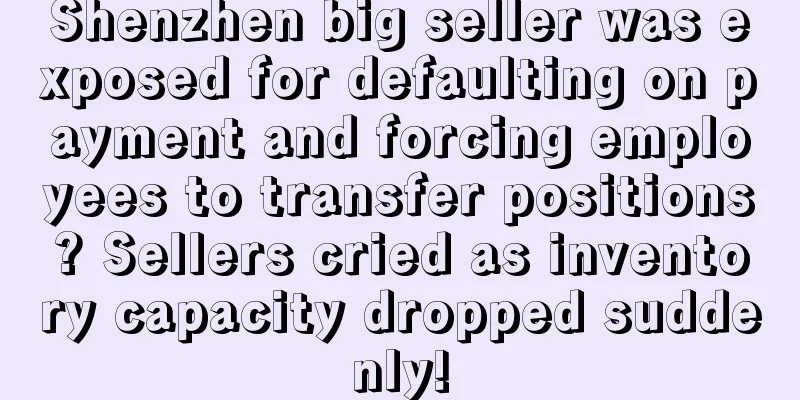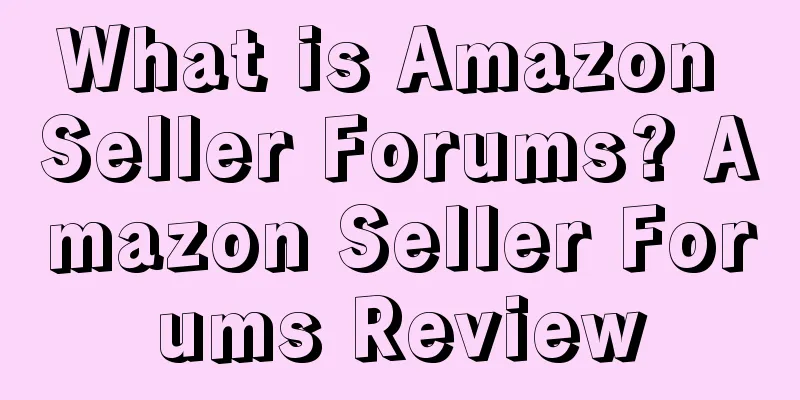Amazon product selection dimensions

|
1. Category Analysis of Product Selection 1. Market capacity Market capacity is the market demand, and production is determined based on demand. Sellers should not think that they have discovered a new world just because they have few product listings. Some products may only have around 2,000 listings, and after a few orders, the products can be on the homepage. However, since the market capacity is very small and the demand is limited, no matter what they do, it is impossible to make them a hit. Market capacity can be determined in the following ways:
2. Industry category analysis Cross-border product selection is like taking the college entrance examination. Whoever can guess the types of questions in the college entrance examination and prepare in advance is more likely to get a high score. The same is true for cross-border product selection. If we can be one step ahead and find potential hot-selling categories first, the next big seller may be you. Let's analyze the popular categories in recent years.
3. Category node selection When sellers are selecting products, they can first analyze the product through category nodes. For example, during the Christmas season, there is only one best-selling LED candle light in a category. Sellers can use keywords to search for the top five sales and which categories of products have the best sales. If a product sells 10 orders a day and is ranked outside the top 1,000 in your current most accurate category or outside the top 100 in a small category, sellers can analyze whether there are adjacent categories that can achieve the best sales with 10 orders a day, and strive for the best sales in that category. At the same time, sellers should not change their categories at will. One of your categories must be responsible for accuracy, and the other category is to get the best sales mark. This is an operational skill. 2. Product Analysis in Product Selection 1. Search popularity The demand for a product can be seen through search popularity. By searching for keywords, you can see the monthly search volume of buyers, and this monthly search volume represents the demand. After understanding the market demand of buyers, choose a product that is in short supply in the market. What is a product in short supply? It means that the search volume of buyers is many times greater than the number of current competitors. This kind of product usually has its own traffic. 2. Product Trends People change their clothing as the seasons change, and products are created to meet different needs. Here is an example: A student said that he had used all the operation skills that the instructor had mentioned, but there were no orders for the product. He opened his link and saw what product it was. In December last year, he sold an outdoor stainless steel kettle. The instructor asked him to use his core keywords to Google to see how many people needed this thing in the current season. Then he checked and said that the current traffic had fallen to a low point. The reason why the student had no orders was that he violated the season. The most popular season for outdoor products is around August to October, and December is when it is icy and snowy. Who would take a stainless steel kettle and run outdoors to use it? Therefore, trend analysis is very important. On the one hand, it allows sellers to understand the hot period of the product and how long in advance the sellers need to prepare to seize its traffic opportunities. On the other hand, it reminds sellers to filter out products that are not suitable for the current season and not to make wrong decisions in the wrong season. 3. Profit margin calculation Every Amazon seller knows that to achieve ideal results, there must be enough profit margin. Therefore, when selecting products, sellers must comprehensively consider the costs of all aspects, calculate the profit margin of the product, and comprehensively decide whether to choose this product. First of all, we need to be clear about the various expenses we may face after joining Amazon. Putting aside the most basic costs of running a company (purchasing, labor, water and electricity), just from the Amazon perspective, we will face these expenses: store rent, commissions, FBA fees, various settlement fees, etc. Sellers can choose products with high average order value and profits. The recommended profit margin is at least between 30% and 50%. After all, in the current fierce competition, Amazon's operations are no longer successful with a single-dimensional advantage. To achieve results in operations, you must make full use of various operation skills, and many skills and methods require capital investment. It can be imagined that a product with a high profit margin and a low absolute profit value is not enough to support active operation methods such as in-site advertising. As the saying goes, knowledge is power, and knowing what a product can bring us is the first step to calculating and maintaining sufficient profits. 4. Pricing Analysis For example, many stylish underwear brands in China want to sell swimwear on Amazon. Sellers believe that good brands and good quality products should be sold at a price of at least $25. However, the current market price of swimwear is between $10 and $20. Therefore, sellers have to give up because the price range of the platform represents the preference of buyers. If the price range is exceeded, sales will be limited. Because foreigners usually buy swimsuits in winter and summer, but they use them for vacation, throw them away after use, and buy them again next time. With such shopping habits, if sellers want to make a product with both brand quality and high price, it will not work. The price must be close to the market. The price is not set by the seller, but by the market. The seller should set the price according to the general price range in the market, rather than just according to their own cost, otherwise it will violate the market law. So how do you set a price? When you don’t have a product yet and you don’t know the product’s sales price, product cost price, and logistics costs, you can compare them through some channels. For the product’s sales price, you can make a comprehensive comparison through some shopping platforms; for the product’s ex-factory price, you can go to some B2B websites. In our product selection and development outline, there are also formulas and analysis articles about product pricing. Sellers can go and check out some specific formulas and analysis. 3. Competitive analysis of product selection 1. Competitive product listing analysis First of all, sellers can understand the listing time of competing products. Generally, if the competing products have been listed for more than two years and the star rating and sales volume are still very high, we do not recommend you to sell such products. Because if the quality of the product is not a big problem, the purchase price is not high, the volume is small, and the top five categories have reached a certain maturity, the seller will have no advantage in selling it. As a new seller, unless you have some new features that can kill it in seconds or subvert it, you will not be able to compete with them. In addition, before selecting products, sellers also need to analyze the listings and copywriting of competing products. Knowing yourself and your enemy will ensure victory in every battle. Before choosing a product, sellers should evaluate the strength of their competitors. Do they have experience and skills in operation? Take a pet product as an example. There are only two sellers of similar products on the market. When we took a look at these two sellers, we found that the pictures were very low-quality and the copywriting was very poorly written, so we knew that these were inexperienced sellers. After analyzing the other party's strength, sellers will be more confident in surpassing its current sales volume when making products. If the competitor is a big brand in the 3C category, do not compete with them head-on, because their brand effect will absorb most (90%) orders in this category. 2. Sales monitoring In fact, there is no need to say more about this. Why do competitors have good sales? One important reason is that the products are popular and meet the current market demand. Of course, when sellers find that a product has good sales data, in addition to combining product reviews, they also need to see whether the product is a seasonal holiday product, whether these products still have market potential in the future, and whether their own manufacturers have production capacity, how much time is needed to produce and put on the shelves, and whether the product still has sales potential after this time. At the same time, see which model and color of competitors' products have the best sales, which can help you select products and launch new products in the early stage. If you encounter a situation where only the top 5 sellers have sales, and the top 20 have no sales, you should be cautious about such products. Because the seller may not be able to push to the top 5, and even if he pushes to the top 20, there will be no sales. Such products are meaningless. 3. Review research First, sellers can check how many reviews their competitors have for their products in the same category. You should know that reviews are an important factor affecting conversions and whether a product can get a better ranking. If you see that the reviews of competitors' products are hundreds or thousands, sellers can consider whether to sell this product, after all, the competition is very fierce. From the perspective of product reviews, you can find products that have good sales but not many reviews. In addition, for a product, Review is a very good feedback information. We need to know whether the market customers are satisfied with this product. We need to look at the Reviews, find the Listings with more Reviews, list all the good and bad Reviews, and summarize the points that customers are more satisfied with and dissatisfied with for this type of product. We can get the reasons why this type of product is currently popular with buyers from the positive reviews and summarize its advantages. For the unsatisfactory aspects, we can see if we have the ability to improve and optimize the product and sell the points that others cannot do as our own characteristics to attract more customers; otherwise, we have to choose to eliminate the products that cannot be done. 4. Differentiation analysis Public model products lack uniqueness and are easily copied. Not only do they have no highlights, but they are also copied, which can easily disrupt the operation rhythm. Therefore, when selecting products, sellers should try their best to give priority to products that can be differentiated. The differentiated transformation mentioned here does not simply mean that it must be a private model product. It means that small-scale changes can be made easily and quickly based on existing products to differentiate the products or have new upgrades. These differentiated transformations can be silk-screen logos, changing parts colors, independent customized packaging, etc. 4. Supply Chain Analysis of Product Selection 1. Intellectual property risk control If you want to run your store for a long time as an Amazon seller, you must stay away from infringement. This is because infringement is too harmful. At the very least, your listing will be deleted. At the worst, your account may be restricted, or you may even be pursued by the right holder for compensation. The result may be that even if you give up all your previous profits, it will not be enough to pay the compensation! In addition, if the seller encounters infringement during operation, it will also affect the seller's mentality. If the seller cannot operate with high morale, it will be difficult to succeed. Therefore, the seller must try to eliminate any possible infringement as soon as possible when selecting products. 2. Suppliers When choosing suppliers, it is generally recommended that novice sellers choose Alibaba first, because everyone is familiar with this platform and can have a better grasp of suppliers. For suppliers, you need to focus on product prices, product production time, product delivery cycle, product quality and other aspects. In addition, sellers need to be wary of second-hand suppliers. Sellers should try to choose products with high-quality supply chains. High-quality supply chains have three advantages: first, they can ensure product quality; second, if the product becomes a hit, there will be a stable and sufficient supply; third, they can provide support and motivation for product transformation. 3. Logistics cost accounting Many small and medium-sized sellers may give priority to small and light products at the beginning of their operation, because such products have convenient logistics and low transportation costs. This is true, but it is also because of this that the entry threshold for such products is low, there are more competitors, and the operation of such products needs to face more intense competition. Correspondingly, if you have sufficient funds, you might as well choose products that are large in size, heavy in weight, and require specific delivery channels. The reason is simple, this itself is a threshold, which blocks a considerable number of sellers without strength from entering the door. Currently, the logistics modes that everyone uses for Amazon are FBA (Fulfilled by Amazon) and FBM (Fulfilled by the Seller). In comparison, FBA has more advantages by relying on the Amazon platform, and both delivery and after-sales service are completed by Amazon, but the cost is higher. If it is self-delivered, it is a little more troublesome, and the seller needs to pack and ship by himself, and the after-sales service is not very guaranteed. Note: When making logistics choices, you should consider various factors such as logistics costs, after-sales and inventory management. There is a saying on Amazon: 70% depends on product selection and 30% depends on operation. This shows the importance of product selection. Especially for novice sellers, they don’t know where to start in product selection. |
<<: Amazon product operation model
>>: What are the Amazon product selection tools? How to use them?
Recommend
What is Shopping.com? Shopping.com Review
Shopping.com is a shopping comparison and consumer...
What is PCI DSS? PCI DSS Review
The full name is Payment Card Industry Data Securi...
Another batch of cross-border companies are giving annual leave! 4 months of paid leave VS variable salary!
▶ Video account attention cross-border navigation ...
Help! A girl born after 1995 works for Amazon, but her boss deducts 100,000 yuan from her commission
8 months ago, I resigned from a large retail comp...
What is BigTracker? BigTracker Review
BigTracker is an easy-to-use Amazon product resear...
Breaking news! Just now, this place has entered a major disaster state!
On February 20, local time, the White House issued...
What is Long Tail Pro? Long Tail Pro Review
Long Tail Pro is a powerful keyword research softw...
What is Google Alerts? Google Alerts Review
Google Alerts is a free service provided by the se...
45,000 Temu exclusive children's pajamas recalled! There is a risk of burns
It is learned that the U.S. Consumer Product Safet...
A complete guide to Amazon overseas marketing: Creating hot-selling products on Amazon
What I want to share with you today is -- A compl...
Attention to Amazon France and Germany sellers: Failure to register for EPR will be considered illegal
Table of contents 1/ What is EPR? 2/ Do I need to ...
What is partnersmk? partnersmk review
partnersmk is an international B2C fast fashion e-...
What is FDA? FDA Review
The U.S. FDA (Food and Drug Administration) is the...
The top 500 American brands in 2023 are announced! Amazon regains the top spot!
It is learned that according to the "Top 500 ...
Trump may launch Tariff 2.0, which will have a profound impact on cross-border e-commerce!
As the day of Trump's return to the White Hous...









